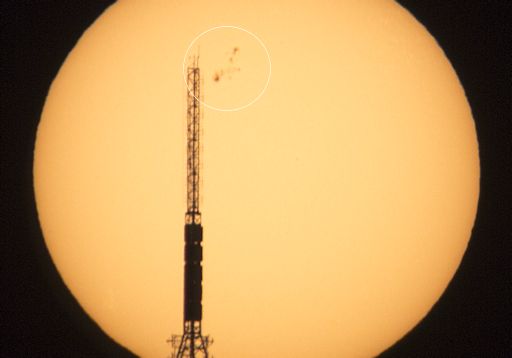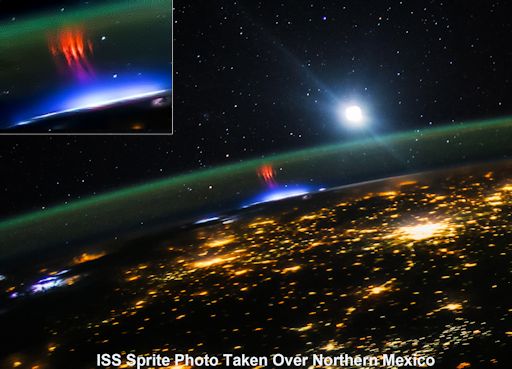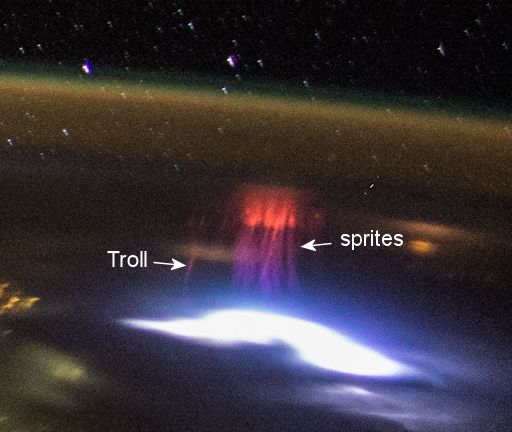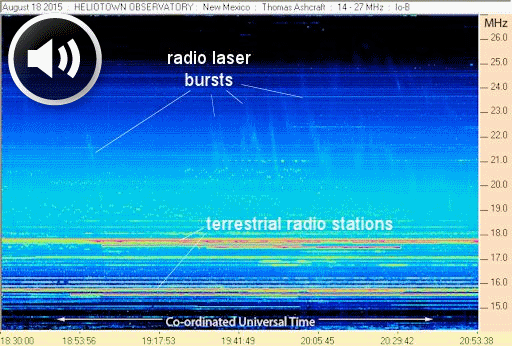Marianne's Heaven On Earth Aurora Chaser Tours Chasethelighttours.co.uk invites you to join them in their quest to find and photograph the Aurora Borealis. Experience the winter wonderland in the Tromsø Area. | | |
CHANCE OF WEEKEND STORMS: NOAA forecasters estimate a 70% chance of minor geomagnetic storms on Aug. 23rd when a solar wind stream expected to hit Earth's magnetic field. High-latitude sky watchers should be alert for auroras. The hours around local midnight is often the best time to look. Aurora alerts: text or voice
X-FLARES IN THE OFFING? Sunspot AR2403 continues to grow. It has more than quadrupled in area since Friday and now stretches across an expanse of the sun's surface more than 130,000 km wide. Of greater significance, it has a "beta-gamma-delta" magnetic field that harbors energy for powerful X-class solar flares. As this photo shows, the sunspot is almost directly facing Earth:

"I got a good view of AR2304 on Aug. 22nd," reports photographer Ian Griffin of Portobello, New Zealand. "The rocket-like object beside the sunspot is a large TV transmission mast, some 5km away. A stunning sight!"
AR2304 is now crackling with M-class solar flares--four in the past 24 hours alone. This is causing a series of minor radio blackouts at frequencies mainly below 5 to 10 MHz. Ham radio operators and mariners are the type of people who might notice such events. NOAA forecasters estimate a 35% chance of more M-class solar flares and a 10% chance of X-flares in the next 24 hours. Solar flare alerts: text or voice
Realtime Space Weather Photo Gallery
SPRITES AND TROLLS AT THE EDGE OF SPACE: We all know what comes out of the bottom of thunderclouds: lightning. But rarely do we see what comes out of the top. On August 10th, astronauts onboard the International Space Station were perfectly positioned to observe red sprites dancing atop a cluster of storms in Mexico. They snapped this incredible photo:

This shows just how high sprites can go. The photo shows their red forms reaching all the way from the thunderstorm below to a layer of green airglow some 100 km above Earth's surface. This means sprites touch the edge of space, alongside auroras, meteors and noctilucent clouds. They are a true space weather phenomenon.
A few minutes after the astronauts saw the sprites, they spotted a related creature--a "Troll." It jumped up to the left of the sprites:

"Trolls are also known as 'secondary transient luminous events," explains Oscar van der Velde, a member of the Lightning Research Group at the Universitat Politècnica de Catalunya. "They are occasionally observed alongside big clusters of sprites, and they can reach 40-60 km high."
Van der Velde says that sprites can actually pull Earth's ionosphere down toward the thunderstorm. When the gap shrinks, and the local electric field intensifies, Trolls appear.
You don't have to be onboard a spaceship to see these exotic forms of lightning. "Sprite chasers" regularly photograph the upward bolts from their own homes. Van der Velde has photographed Trolls from ground-level, too. "I recorded these trolls last October over a storm over the Mediterranean Sea west of Sardinia and Corsica," he says. Browse the sprite gallery for more examples.
Realtime Sprite Photo Gallery
RADIO STORM ON JUPITER: Two days ago, amateur astronomer Thomas Ashcraft of New Mexico pointed his radio telescope at the sun, something he does on a regular basis to monitor solar activity. As if on cue, the loud speaker erupted in a series of hisses and crackles. However, the source of the static wasn't the sun--it was Jupiter. "I detected a powerful radio storm on Jupiter," he says. Click on the image to play the 'rat-a-tat-tat' sounds of the giant planet:

"Jupiter was overhead at noon local time and right in the sweet spot of my radio telescope," says Ashcraft. "The radio storm lasted a full two hours."
Jupiter is a powerful source of shortwave radio bursts. They come from natural radio lasers in the giant planet's magnetosphere. Electrical currents flowing between Jupiter's upper atmosphere and the volcanic moon Io can boost these emissions to power levels easily detected by ham radio antennas on Earth. That's what happened on August 18th. Each of the sharp crackles in the recording coresponds to a single radio laser beam sweeping past Earth as Jupiter rotates.
Ashcraft notes that Jupiter is passing behind the sun this week, "so Jupiter is about as far away from Earth as it ever gets. I detected these bursts from a distance of 955,022,185 kilometers."
To learn more about radio storms on Jupiter, and how you can observe them yourself, visit NASA's RadioJove web site.
Realtime Aurora Photo Gallery
Realtime Venus Photo Gallery
Realtime NLC Photo Gallery
Every night, a network of NASA all-sky cameras scans the skies above the United States for meteoritic fireballs. Automated software maintained by NASA's Meteoroid Environment Office calculates their orbits, velocity, penetration depth in Earth's atmosphere and many other characteristics. Daily results are presented here on Spaceweather.com.
On Aug. 22, 2015, the network reported 22 fireballs.
(21 sporadics, 1 Southern delta Aquariid)

In this diagram of the inner solar system, all of the fireball orbits intersect at a single point--Earth. The orbits are color-coded by velocity, from slow (red) to fast (blue). [Larger image] [movies]
Potentially Hazardous Asteroids (
PHAs) are space rocks larger than approximately 100m that can come closer to Earth than 0.05 AU. None of the known PHAs is on a collision course with our planet, although astronomers are finding
new ones all the time.
On August 22, 2015 there were 1607 potentially hazardous asteroids.
Notes: LD means "Lunar Distance." 1 LD = 384,401 km, the distance between Earth and the Moon. 1 LD also equals 0.00256 AU. MAG is the visual magnitude of the asteroid on the date of closest approach. | | The official U.S. government space weather bureau |
| | The first place to look for information about sundogs, pillars, rainbows and related phenomena. |
| | Researchers call it a "Hubble for the sun." SDO is the most advanced solar observatory ever. |
| | 3D views of the sun from NASA's Solar and Terrestrial Relations Observatory |
| | Realtime and archival images of the Sun from SOHO. |
| | from the NOAA Space Environment Center |
| | the underlying science of space weather |
| | Web-based high school science course with free enrollment |

